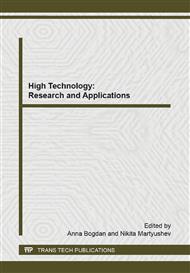[1]
A.P. Lyashko, A.A. Medvinskii, G.G. Savel'ev, A.P. Il'in, N.A. Yavorovskii, Reaction of submicron aluminum powders with liquid water, Macrokinetics, products, self-heating, Kinetics and Catalysis 31 (1991) 848–853.
Google Scholar
[2]
S. Tarasov, A. Kolubaev, S. Belyaev, M. Lerner, F. Tepper, Study of friction reduction by nanocopper additives to motor oil, Wear 252 (2002) 63–69.
DOI: 10.1016/s0043-1648(01)00860-2
Google Scholar
[3]
A.P. II'in, V.V. An, V.I. Vereshchagin, G.V. Yablunovskii, End combustion products of mixtures of ultrafine aluminum with a zirconium-aluminum alloy in air, Combustion, Explosion and Shock Waves 36 (2000) 209–212.
DOI: 10.1007/bf02699362
Google Scholar
[4]
Y. Kwon, Y. Jung, N.A. Yavorovsky, A.P. Illyn, J. Kim, Ultra-fine powder by wire explosion method, Scripta Materialia 44 (2001) 2247–2251.
DOI: 10.1016/s1359-6462(01)00757-6
Google Scholar
[5]
A.P. Ilyin, O.B. Nazarenko, D.V. Tikhonov, Production of tungsten powders by electrical explosion of wires, Journal of Optoelectronics and Advanced Materials 10 (2008) 645–648.
Google Scholar
[6]
A.P. Ilyin, O.B. Nazarenko, G.V. Shuvalov, I.V. Klekovkin, D.V. Tikhonov, L.O. Tolbanova, Production and characterization of molybdenum nanopowders obtained by electrical explosion of wires, Optoelectronics and Advanced Materials, Rapid Communications 4 (2010).
Google Scholar
[7]
N. Yavorovskii, Fabrication of ultra-dispersed powders by electrical explosion methods, Bulletin of higher education institution. Physics (In Russian) 4 (1996) 114–36.
Google Scholar
[8]
V. An, F. Bozheyev, F. Richecoeur, Y Irtegov, Synthesis and characterization of nanolamellar tungsten and molybdenum disulfides, Materials Letters 65 (2011) 2381–2383.
DOI: 10.1016/j.matlet.2011.05.048
Google Scholar
[9]
H.H. Kun, G.H. Xian, J.S. Xiao, Morphological effect of MoS2 nanoparticles on catalytic oxidation and vacuum lubrication, Applied Surface Science 256 (2010) 2517–2523.
DOI: 10.1016/j.apsusc.2009.10.098
Google Scholar
[10]
F. Chuanqi, H. Lunfeng, G. Zaiping, L. Huakun, Synthesis of tungsten disulfide (WS2) nanoflakes for lithium ion battery application, Electrochemistry Communications 9 (2007) 119–122.
DOI: 10.1016/j.elecom.2006.08.048
Google Scholar
[11]
L. Rapoport, Y. Feldman, M. Homyonfer, H. Cohen, J. Sloan, J.L. Hutchison, R. Tenne, Inorganic fullerene-like material as additives to lubricants: structure–function relationship, Wear 225–229 (1999) 975–982.
DOI: 10.1016/s0043-1648(99)00040-x
Google Scholar
[12]
Y. Irtegov, V. An, M. Azhgikhin, Study of nanostructured metal sulfides produced by self-propagating high-temperature synthesis, Proceedings - 7th International Forum on Strategic Technology, IFOST 2012 (2012) article number 6357544.
DOI: 10.1109/ifost.2012.6357544
Google Scholar


